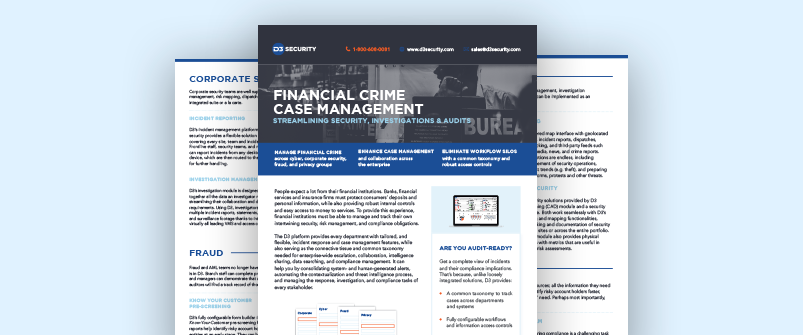

The Challenge:
Dealing with crime is nothing new for financial institutions. The lucrative target they present has always inspired innovation and persistence among thieves, fraudsters, and other criminals, but the digital era is increasing the potential attack surface to a previously unthinkable degree. The old challenges still exist, but now with the ubiquitous use of IT systems, financial institutions also have to protect their digital infrastructure, which might include online banking, mobile apps, third-party payment systems, networks, and ATMs.
At the same time, there has been a dramatic rise in fines resulting from regulatory violations and data breaches, raising the stakes for detecting and preventing incidents, and intertwining the mandates of compliance and security teams.
Cybersecurity, corporate security, fraud, and privacy teams may be on the front lines of dealing with financial crime, but other departments are impacted as well. This creates a need for seamless collaboration between traditionally separated groups, which in many organizations is made impossible by a patchwork of security solutions. The costs of breaking down the siloes and establishing universal systems can be prohibitive, and conventional solutions like adding middleware, systems integration, and data abstraction layers only serve to increase cost and complexity.
The Solution:
The breadth of these challenges requires a tightly coordinated response, which necessitates an enterprise-wide incident management platform like D3. By consolidating on one incident management platform, teams across the organization are able to:
- Collaborate and communicate during incident response and case management processes.
- Collect and correlate information from different groups and conduct integrated analysis on the data to inform the risk management program.
- Produce more accurate metrics, root cause analyses, and countermeasures, based on standardized data handling.
Through D3’s configuration options, customized dashboards, and specialized toolsets, each department can achieve the precise functionality they require, without relying on a siloed point solution. This enterprise-wide deployment is further supported by granular information access controls that manage data visibility across departments and roles. Access controls are critical for enforcing the standards that ensure investigations and incident responses meet compliance and privacy requirements.
The Outcome:
While implementing any incident management tools might help your institution combat financial crime, uniting your efforts under one enterprise-wide platform has an effect that is greater than the sum of its parts.
Faster Actions: With an enterprise-wide incident management system, institutions can act faster throughout all areas of financial crime, including:
- Faster fraud identification
- Faster incident response
- Faster case closure
- Faster compliance reporting—because the relevant data is collected and accessible
- Faster validation of major threats
Efficiency: Consolidating into a centralized platform makes security, risk, and compliance operations highly efficient. Less time spent gathering data from disparate systems means there is more time to spend on investigations. Time and money are also saved by avoiding expensive alternatives like systems integration, upgrades on numerous systems, bringing in consultants, etc.
Unified System and Procedures: Centralized incident management supports consistent processes across the organization. Because everyone is working off of the same system with collaborative tools, it becomes easy for teams to align on goals and procedures. New departments can also easily be added to the platform.
Improved Security: Bringing together the processes used for fighting the different types of financial crime strengthens security in general. By making more data available for analysis, correlation, and post-incident assessment, all teams receive the tools they need to better identify and prepare for emerging risks.
Read the Guide
We recently published a document further detailing how D3’s platform can be used by institutions to combat financial crime. Download it from our resources page Download it from our resources to learn how D3 provides a centralized tool for incident response and case management across corporate security, cyber, fraud, privacy, and compliance.
